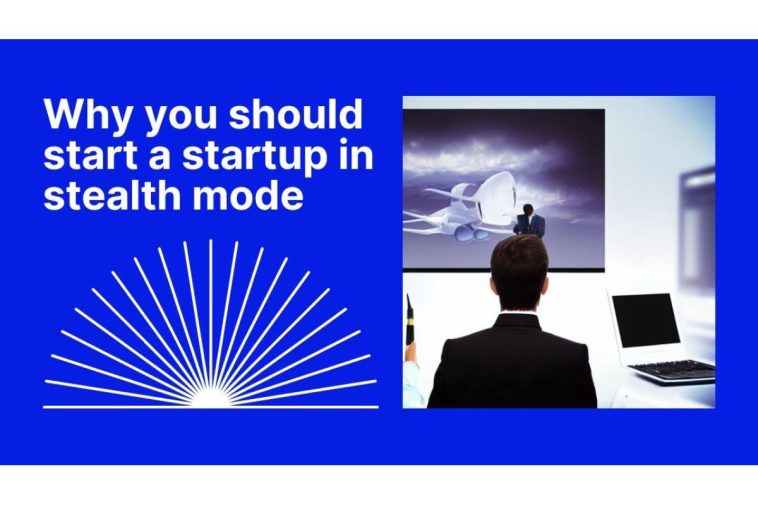A stealth mode startup refers to a company or business venture that operates secretively, intentionally keeping its activities, products, or services under wraps from the public and often from competitors. The term “stealth mode” implies that the startup operates in stealth or hidden mode, avoiding public attention, media coverage, and external scrutiny.
Startups may choose to operate in stealth mode for several reasons:
1. Intellectual Property Protection:

Using stealth mode, startups can safeguard their innovative ideas, technologies, or inventions from being copied or imitated by competitors. It allows them to secure patents, trademarks, or copyrights before revealing their offerings to the public.
2. Competitive Advantage:
Remaining in stealth mode allows startups to develop their product or service without revealing their progress to competitors. This way, they can gain a significant head start or advantage in the market by launching a more polished and refined offering.
3. Market Testing:
Stealth mode allows startups to test their product or service in a controlled environment, collecting feedback and refining their offerings before making a public debut. This approach will enable them to iterate and improve based on real-world insights.
4. Funding Strategy:
Some startups operate stealthily to attract strategic investors or venture capitalists without revealing their business idea to the public. By sharing limited information under non-disclosure agreements, they can generate interest and secure funding based on the potential of their concept.
While operating in stealth mode, startups typically maintain a low profile, limit public communication, and restrict access to information about their operations. However, they may selectively engage with specific partners, advisors, or potential investors under confidentiality agreements to support their growth and development.
Once a startup feels ready to launch its product or service, it will transition out of stealth mode and initiate a more public-facing approach to build brand awareness, attract customers, and compete in the market.
While stealth mode startups have gained popularity in recent years due to their potential advantages, it’s essential to recognize that they also come with some drawbacks.
Here are a few disadvantages commonly associated with stealth-mode startups:
1. Limited Public Exposure:
By operating in stealth mode, startups restrict their public disclosure and brand awareness. This lack of visibility can make it challenging to attract potential customers, partners, or investors who may be hesitant to engage with a company they know little about. Building trust and credibility can be more difficult without a public presence.
2. Difficulty Building a User Base:
Startups in stealth mode often keep their product or service hidden from the public until it is fully developed or closer to launch. This approach can make it challenging to gather user feedback and validate the product in the early stages. Feedback from early adopters is crucial for refining the offering and addressing potential market needs.
3. Missed Networking Opportunities:
Operating in stealth mode limits a startup’s ability to network and build connections within the industry. Participating in conferences, events, and meetups can provide valuable opportunities for networking, finding potential partners or collaborators, and gaining insights from experienced professionals. A stealth startup may miss these valuable connections by avoiding public engagement.
4. Competitive Disadvantage:
While stealth mode can help protect a startup’s intellectual property and prevent competitors from copying their ideas. It also means that the startup may not be aware of emerging competition or market trends. This lack of awareness can result in a slower response to market changes and an increased risk of being caught off guard by competitors operating openly.
5. Recruitment Challenges:
Hiring top talent can be more challenging for stealth-mode startups. Without a public presence, attracting skilled individuals who may prefer to join companies with a proven track record or a clear vision and mission can be difficult. Additionally, potential employees may hesitate to join a company with limited information about its product, market, or prospects.
Funding Limitations:
While stealth mode can create a sense of exclusivity and generate interest from investors, it can also make it harder to secure funding. Investors typically prefer startups with compelling stories, traction, and a clear value proposition. The lack of public information and proof of concept can make it difficult for stealth startups to demonstrate these aspects. It thus leads to potential funding challenges.
It’s important to note that the drawbacks mentioned here are not absolute. They can also vary depending on the specific circumstances and industry in which a startup operates. Additionally, some startups may find ways to mitigate these challenges through targeted marketing efforts, strategic networking, and other creative approaches.
Conclusion
The decision to adopt stealth mode should be the basis of the specific circumstances and goals of the startup. It’s essential to weigh the potential benefits against the potential drawbacks. You should also consider alternative strategies to mitigate these challenges, such as targeted marketing, strategic networking. You can also selectively reveal essential information to specific stakeholders. Every startup is unique, and finding the right approach to visibility and public engagement is crucial for long-term success.




GIPHY App Key not set. Please check settings